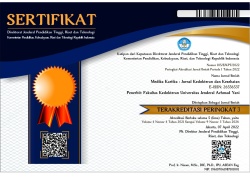KARAKTERISTIK BIOFILM Candida albicans DAN BEBERAPA ANTIBIOFILMNYA
Abstract
Candida albicans merupakan anggota mikrobiota normal pada tubuh manusia yang sehat dengan sistem kekebalan tubuh yang baik. Namun, adanya gangguan keseimbangan akibat beberapa faktor dapat mengakibatkan C. albicans berkembang biak dengan cepat dan menyebabkan infeksi. Kemampuan C. albicans dalam menginfeksi salah satunya didukung oleh faktor virulensi, yaitu aktivitasnya dalam pembentukan biofilm. Tulisan ini bertujuan untuk mengetahui karakteristik biofilm C. albicans dan potensi zerumbone, madu jujube, dan enzim β-1,3-glukanase sebagai antibiofilm C. albicans. Hasil studi literatur berdasarkan telaah jurnal didapatkan karakteristik biofilm C. albicans memiliki perbedaan dengan organisme planktonik, hal ini seringkali dikaitkan dengan keunggulan biofilm dengan sifat resistensi dan virulensinya. Selain itu, karakteristik antar biofilm C. albicans juga dapat berbeda sesuai dengan faktor yang mempengaruhinya, perbedaan ini berhubungan dengan proses adhesi, perubahan produksi biofilm, aktivitas metabolisme, serta kekuatan perlekatan biofilm pada permukaan. Zerumbone secara signifikan diketahui menurunkan tingkat ekspresi gen terkait biofilm dan spesifik terhadap hifa, madu jujube dapat menyebabkan perubahan pada dinding sel dan eksopolisakarida, dan enzim β-1,3-glukanase memiliki kemampuan untuk mendegradasi komponen polimer matriks ekstrasel pada biofilm. Ketiga bahan antibiofilm ini diketahui dapat mencegah pembentukan biofilm dan mendegradasi biofilm C. albicans yang telah terbentuk.
References
2. Noor, C. K. putri dan trisna insan. Kajian Molekuler Resistensi Candida albicans Terhadap Antifungi. Anal. pendapatan dan tingkat Kesejaht. rumah tangga petani 53, 1689–1699 (2013).
3. Wall, G., Montelongo-Jauregui, D., Vidal Bonifacio, B., Lopez-Ribot, J. L. & Uppuluri, P. Candida albicans biofilm growth and dispersal: contributions to pathogenesis. Current Opinion in Microbiology vol. 52 1–6 (2019).
4. Masfufatun, Bayasud, S. L., Yasinta, M. S., Ni’matuzahro & Baktir, A. Serum acetaldehyde as a potential biomarker for the detection of pathogenic biofilm formation by Candida albicans. J. Chem. Technol. Metall. 52, 1032–1038 (2017).
5. Cavalheiro, M. & Teixeira, M. C. Candida Biofilms: Threats, Challenges, and Promising Strategies. Frontiers in medicine vol. 5 28 (2018).
6. Masfufatun, M. et al. New phenomena for clinicians, model of Candida albicans mobilization before and after biofilm formation in the intestinal mucosa of Wistar rats (Rattus norvegicus). Int. J. One Heal. (2021) doi:10.14202/ijoh.2021.165-170.
7. Tsui, C., Kong, E. F. & Jabra-Rizk, M. A. Pathogenesis of Candida albicans biofilm. 74, 18 (2016).
8. Lohse, M. B., Gulati, M., Johnson, A. D. & Nobile, C. J. Development and regulation of single-and multi-species Candida albicans biofilms. Nat. Rev. Microbiol. 16, 19–31 (2018).
9. Zarnowski, R. et al. Candida albicans biofilm–induced vesicles confer drug resistance through matrix biogenesis. PLoS Biol. 16, 1–18 (2018).
10. Jackson, S., Coulthwaite, L., Loewy, Z., Scallan, A. & Verran, J. Biofilm development by blastospores and hyphae of Candida albicans on abraded denture acrylic resin surfaces. J. Prosthet. Dent. 112, 988–993 (2014).
11. Frade, J. P. & Arthington-Skaggs, B. A. Effect of serum and surface characteristics on Candida albicans biofilm formation. Mycoses 54, 154–162 (2011).
12. da Silva, W. J. et al. Influence of surface free energy of denture base and liner materials on Candida albicans biofilms. J. Investig. Clin. Dent. 6, 141–146 (2015).
13. Shin, D. S. & Eom, Y. Bin. Zerumbone inhibits candida albicans biofilm formation and hyphal growth. Can. J. Microbiol. 65, (2019).
14. Shin, D. S. & Eom, Y. Bin. Efficacy of zerumbone against dual-species biofilms of Candida albicans and Staphylococcus aureus. Microb. Pathog. 137, (2019).
15. Hamzah, H., Hertiani, T., Pratiwi, S. U. T., Nuryastuti, T. & Gani, A. P. Antibiofilm studies of zerumbone against polymicrobial biofilms of staphylococcus aureus, escherichia coli, pseudomonas aeruginosa, and candida albicans. Int. J. Pharm. Res. 12, (2020).
16. Ansari, M. J. et al. Effect of jujube honey on Candida Albicans growth and biofilm formation. Arch. Med. Res. 44, 352–360 (2013).
17. Wabaidur, S. M. et al. Total phenolic acids and flavonoid contents determination in yemeni honey of various floral sources: Folin-ciocalteu and spectrophotometric approach. Food Sci. Technol. 40, (2020).
18. Freires, I. A. et al. Chemical composition and antifungal potential of Brazilian propolis against Candida spp. J. Mycol. Med. 26, (2016).
19. Budiarti, S. W. & Widyastuti, S. Aktifitas antifungal β -1 , 3-glukanase Trichoderma reesei Pada fungi akar Ganoderma philippii Ganoderma philippii. Widyariset 14, 455–460 (2011).
20. Tan, Y., Ma, S., Leonhard, M., Moser, D. & Schneider-Stickler, B. β-1,3-glucanase disrupts biofilm formation and increases antifungal susceptibility of Candida albicans DAY185. Int. J. Biol. Macromol. 108, 942–946 (2018).
21. Baktir, A., Suwito, H., Safinah, M. & Kunsah, B. Novel Materials for Eradication of Biofilm Extracell Matrix of Pathogenic Candida. J. Mater. Sci. Eng. B 2, (2012).
22. Sachivkina, N., Lenchenko, E., Blumenkrants, D., Ibragimova, A. & Bazarkina, O. Effects of farnesol and lyticase on the formation of Candida albicans biofilm. Vet. World 13, (2020).




























